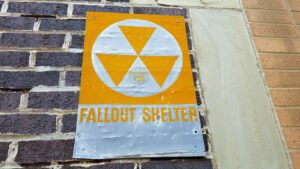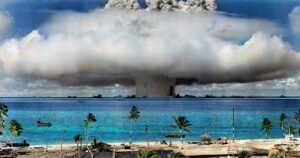What is Nuclear Winter?
Nuclear winter refers to a hypothetical climatic and environmental catastrophe that could occur after a large-scale nuclear war. The concept was first proposed in the early 1980s by scientists who hypothesized that the detonation of numerous nuclear explosions would release massive amounts of black carbon into the atmosphere. This would block sunlight from reaching the Earth’s surface, resulting in a significant drop in global temperatures and causing worldwide cooling. The extreme cold, combined with the reduction in sunlight, would disrupt agricultural systems, leading to widespread crop failure and famine. Additionally, the darkness and lack of sunlight would impact photosynthesis, potentially causing a collapse in the ecosystem and the extinction of many species. While there has been debate and controversy surrounding the extent and likelihood of a nuclear winter, experts agree that even a limited nuclear conflict could have severe and lasting global consequences. It serves as a chilling reminder of the catastrophic effects that nuclear weapons can have on the planet.
How to Survive a Nuclear Winter
Surviving a nuclear winter requires careful planning and preparation. The first step is to find shelter in a location that provides maximum protection from radiation. Underground bunkers or basements with thick concrete walls and limited entrances are ideal. Stockpiling food and water is essential, as the outside world may become uninhabitable for a long period. Canned goods, dried fruits, and grains are good options for non-perishable food items. It is also important to have a reliable source of clean water, which can be stored in large containers or obtained from nearby water sources. Additionally, medical supplies, including first-aid kits and prescription medication, should be readily available. Staying warm is crucial during a nuclear winter, so having extra blankets, warm clothing, and a portable heating source is recommended. Lastly, maintaining communication with others is vital for survival. Radios, walkie-talkies, or satellite phones can be used for this purpose. Surviving a nuclear winter is challenging, but with careful planning and preparation, it is possible to increase the chances of survival.
 Understanding Nuclear War
Understanding Nuclear War
Understanding nuclear war is of utmost importance in today’s uncertain world. The potential devastation caused by a nuclear conflict cannot be overstated. With the advancements in technology and the proliferation of nuclear weapons, the risks associated with a nuclear war have escalated. It is crucial for individuals, governments, and international organizations to comprehend the grave consequences of such a catastrophic event. A comprehensive understanding of nuclear war involves studying the history of past conflicts, analyzing the political motives behind nuclear arsenals, and evaluating the strategic calculations and doctrines involved. Additionally, understanding the physics and psychology of nuclear weapons is imperative in developing effective deterrence strategies and disarmament efforts. In order to prevent the catastrophic loss of life and destruction that a nuclear war would cause, it is necessary to invest in education, research, and dialogue on this critical issue. Only through a deep understanding can we work towards a nuclear-free world, where peace and security prevail.
Types of Nuclear Blasts
Surviving a nuclear winter requires careful planning and preparation. The first step is to find shelter in a location that provides maximum protection from radiation. Underground bunkers or basements with thick concrete walls and limited entrances are ideal. Stockpiling food and water is essential, as the outside world may become uninhabitable for a long period. Canned goods, dried fruits, and grains are good options for non-perishable food items. It is also important to have a reliable source of clean water, which can be stored in large containers or obtained from nearby water sources. Additionally, medical supplies, including first-aid kits and prescription medication, should be readily available. Staying warm is crucial during a nuclear winter, so having extra blankets, warm clothing, and a portable heating source is recommended. Lastly, maintaining communication with others is vital for survival. Radios, walkie-talkies, or satellite phones can be used for this purpose. Surviving a nuclear winter is challenging, but with careful planning and preparation, it is possible to increase the chances of survival.
Types of nuclear blasts can be categorized based on their detonation locations and the extent of destruction they cause. The first type is an airburst, where the nuclear device is detonated in the air, creating a powerful explosion. This type of blast can cause mass destruction over a wide area, including leveling buildings and causing extensive damage to infrastructure. Another type is a surface burst, where the device is detonated on or just above the ground. This type of blast results in a highly destructive shockwave that can cause widespread damage within a limited radius, as well as create significant radioactive fallout. A third type is an underground burst, where the device is detonated below the surface. Although this type of blast generally causes less immediate damage, it can contaminate the soil and water with radioactive material, posing long-term health risks for those exposed. The specific type of nuclear blast determines the level of devastation and the subsequent environmental and health consequences, emphasizing the importance of nuclear non-proliferation efforts to prevent such catastrophic events.
Nuclear Weapons and Atomic Bombs
Nuclear weapons and atomic bombs are perhaps the most destructive creations ever made by mankind. These weapons have the power to annihilate entire cities and cause catastrophic damage on an unimaginable scale. The destructive potential of nuclear weapons is derived from the immense energy released by a chain reaction of atomic fission or fusion. The first and only two atomic bombs used in warfare to date were dropped on the Japanese cities of Hiroshima and Nagasaki during World War II, resulting in the deaths of hundreds of thousands of people and leaving long-lasting physical and psychological scars. The devastating impact of these bombings has served as a stark reminder of the horrifying consequences that arise when such weapons are unleashed. The possession and proliferation of nuclear weapons pose a serious threat to global security and stability. The potential for accidents, miscalculations, or deliberate use of these weapons remains a constant concern. The international community has made significant efforts to curb the spread of nuclear weapons through non-proliferation agreements and disarmament treaties. Ensuring the non-use and non-proliferation of nuclear weapons is crucial to safeguarding humanity’s future.
Delivery Systems for Nuclear Warheads
The development and deployment of delivery systems for nuclear warheads have been a matter of utmost concern for nations possessing these weapons. The design and implementation of such systems require meticulous planning and an array of technical elements to assure their effectiveness. The primary objective of any delivery system is to transport the warhead to its intended target with utmost accuracy and maximum destructive potential. These systems include ballistic missiles, cruise missiles, and bombers, each designed to operate in different environments and fulfill distinct roles in a strategic offensive campaign. Ballistic missiles are the most prevalent and widely recognized delivery systems, capable of reaching targets over long distances in a relatively short timeframe. Cruise missiles, on the other hand, are designed for greater maneuverability and precision in striking specific targets. Bombers offer distinct advantages of flexibility and potential for multiple target engagements. These delivery systems are constantly evolving, with advancements in technology enabling longer ranges, improved accuracy, and enhanced stealth capabilities. The sophistication and reliability of these systems emphasize the need for international arms control regimes to ensure their responsible use and prevent the proliferation and illicit trade of nuclear warheads.
Prepping for Survival
Prepping for survival is not just a trend or a hobby; it is a serious matter that requires diligent planning and preparation. In a world that is vulnerable to natural disasters, economic collapse, and other unforeseen events, being prepared can mean the difference between life and death. Prepping involves acquiring the necessary skills, knowledge, and resources to sustain oneself and one’s family during times of crisis. This includes having a stockpile of non-perishable food, water, and medical supplies, as well as having the ability to protect oneself and one’s property. Additionally, preppers often create contingency plans and emergency evacuation routes to ensure their safety in various scenarios. While some may view prepping as an excessive or paranoid activity, it is a prudent approach to safeguarding one’s wellbeing in an unpredictable world. By being proactive and taking steps to prepare for the worst, individuals can increase their chances of survival and minimize the potential impact of disasters.
Surviving Nuclear Winter
Surviving a nuclear winter is a daunting challenge, given the catastrophic aftermath of a nuclear war. The prolonged period of darkness and cold temperatures, caused by the massive amount of smoke and dust released into the atmosphere, would cause widespread crop failures, leading to food shortages and famine. Adequate preparation and planning are crucial to increase the chances of survival. Stockpiling non-perishable food items, water, and essential supplies such as medicine and warm clothing should be a top priority. Creating underground shelters or fortifying existing structures can provide protection from radiation and harsh weather conditions. Collaboration and community building are imperative to ensure the pooling of resources and skills necessary for long-term survival. Developing sustainable and self-sufficient systems, such as indoor farming and water purification methods, could mitigate the effects of nuclear winter. Furthermore, it is essential to remain informed about radiation levels, government advisories, and any possible aid organizations that may assist during this time of crisis. Maintaining hope, resilience, and adaptability are vital in facing the arduous challenges of surviving nuclear winter.
Creating Survivability Zones
Creating survivability zones is a crucial aspect of disaster preparedness and response. With the increasing frequency and intensity of natural disasters, it is imperative that communities establish safe areas where residents can seek refuge during emergencies. Survivability zones should be strategically located to maximize accessibility and minimize risk. They should be equipped with essential facilities and resources to ensure the well-being and safety of individuals. Adequate shelter, clean water, food supplies, and medical aid must be readily available in these zones. Moreover, effective communication systems and emergency plans should be in place to disseminate vital information and coordinate rescue operations. Regular drills and training programs are also essential to educate residents about the importance of these zones and how to respond effectively in crisis situations. Governments and local authorities have a critical role in identifying suitable locations for survivability zones and allocating resources for their development. By investing in the creation of survivability zones, communities can enhance their resilience and minimize the loss of lives and property in the face of disasters.
 Shelter in Place
Shelter in Place
Strategies Shelter in place strategies are important measures to protect individuals during emergency situations such as natural disasters or man-made incidents. They involve staying indoors and creating a safe haven until it is deemed safe to go outside. One key aspect of sheltering in place is to have an emergency kit ready, which should include essential items like non-perishable food, water, flashlights, batteries, and a first aid kit. During a shelter-in-place scenario, it is crucial to stay informed about the situation by listening to local authorities or emergency broadcasts. In addition, it is important to secure your surroundings by closing and locking all windows, doors, and vents. It is also recommended to use duct tape or plastic sheeting to seal off any gaps or vulnerable areas. It is vital to stay calm and reassure others who may be with you, particularly children. Shelter in place strategies are a proactive approach to ensure personal safety and reduce the risk of exposure to potential hazards.
Survival Skills and Resources
Shelter in place strategies are protocols implemented during an emergency situation such as a natural disaster, active shooter situation, or a terrorist attack. The primary goal of sheltering in place is to protect individuals from any immediate threat by seeking a safe place within their current location and remaining there until it is safe to leave. The strategies may vary depending on the specific situation, but they generally involve finding a room or area with minimal windows, locking or barricading doors, and turning off all lights and electronic devices to maintain silence and avoid being detected by potential threats. It is important to have essential supplies such as food, water, and first aid kits readily available in the sheltered area. Adequate communication is also crucial during a shelter in place situation, so individuals should have a reliable means of receiving updated information and instructions from authorities. Understanding and practicing shelter in place strategies can significantly improve personal safety and increase the chances of surviving a crisis.
Finally..
Surviving a nuclear attack requires careful preparation and planning. Establishing a secure fallout shelter is of paramount importance. These shelters are specifically designed to shield individuals from the harmful effects of radiation and can only be located underground or in well-insulated structures. Stockpiling essential supplies such as food, water, medical kits, and protective gear is also crucial in ensuring survival.
The aftermath of a nuclear explosion presents numerous challenges that survivors must face. Radioactive fallout, consisting of radioactive particles and dust, poses a significant threat to health and must be carefully dealt with. Establishing proper decontamination procedures and learning how to effectively clean food, water, and surfaces from radioactive contamination is essential to reduce the risk of radiation sickness.
Preparing for the unthinkable requires acquiring nuclear war survival skills. Developing a comprehensive emergency plan that covers various scenarios is crucial for individual and collective safety. Educating oneself about nuclear warheads, missiles, and the mechanics of a nuclear blast can help in making informed decisions. Stockpiling essential supplies such as food, water, medicine, and fuel is essential to increase the chances of survival.
